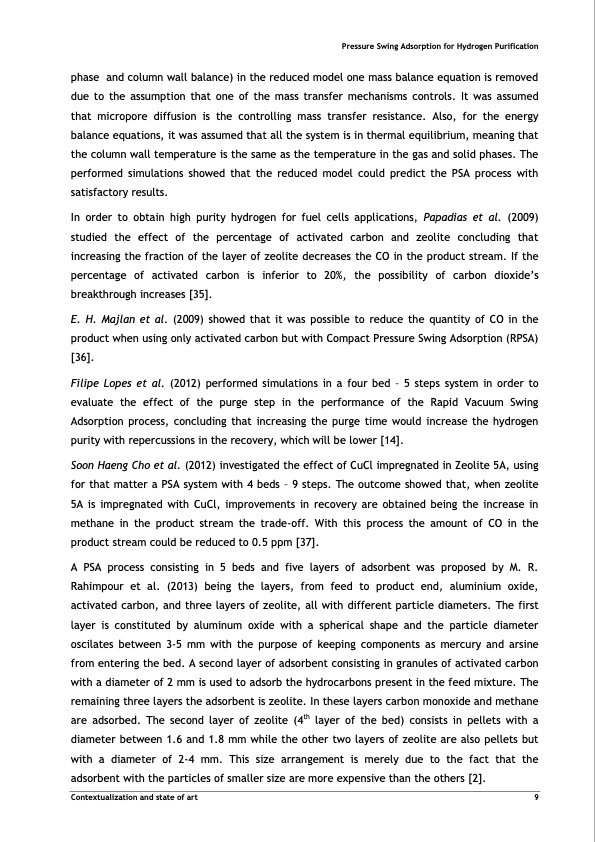
PDF Publication Title:
Text from PDF Page: 029
phase and column wall balance) in the reduced model one mass balance equation is removed due to the assumption that one of the mass transfer mechanisms controls. It was assumed that micropore diffusion is the controlling mass transfer resistance. Also, for the energy balance equations, it was assumed that all the system is in thermal equilibrium, meaning that the column wall temperature is the same as the temperature in the gas and solid phases. The performed simulations showed that the reduced model could predict the PSA process with satisfactory results. In order to obtain high purity hydrogen for fuel cells applications, Papadias et al. (2009) studied the effect of the percentage of activated carbon and zeolite concluding that increasing the fraction of the layer of zeolite decreases the CO in the product stream. If the percentage of activated carbon is inferior to 20%, the possibility of carbon dioxide’s breakthrough increases [35]. E. H. Majlan et al. (2009) showed that it was possible to reduce the quantity of CO in the product when using only activated carbon but with Compact Pressure Swing Adsorption (RPSA) [36]. Filipe Lopes et al. (2012) performed simulations in a four bed – 5 steps system in order to evaluate the effect of the purge step in the performance of the Rapid Vacuum Swing Adsorption process, concluding that increasing the purge time would increase the hydrogen purity with repercussions in the recovery, which will be lower [14]. Soon Haeng Cho et al. (2012) investigated the effect of CuCl impregnated in Zeolite 5A, using for that matter a PSA system with 4 beds – 9 steps. The outcome showed that, when zeolite 5A is impregnated with CuCl, improvements in recovery are obtained being the increase in methane in the product stream the trade-off. With this process the amount of CO in the product stream could be reduced to 0.5 ppm [37]. A PSA process consisting in 5 beds and five layers of adsorbent was proposed by M. R. Rahimpour et al. (2013) being the layers, from feed to product end, aluminium oxide, activated carbon, and three layers of zeolite, all with different particle diameters. The first layer is constituted by aluminum oxide with a spherical shape and the particle diameter oscilates between 3-5 mm with the purpose of keeping components as mercury and arsine from entering the bed. A second layer of adsorbent consisting in granules of activated carbon with a diameter of 2 mm is used to adsorb the hydrocarbons present in the feed mixture. The remaining three layers the adsorbent is zeolite. In these layers carbon monoxide and methane are adsorbed. The second layer of zeolite (4th layer of the bed) consists in pellets with a diameter between 1.6 and 1.8 mm while the other two layers of zeolite are also pellets but with a diameter of 2-4 mm. This size arrangement is merely due to the fact that the adsorbent with the particles of smaller size are more expensive than the others [2]. Contextualization and state of art 9 Pressure Swing Adsorption for Hydrogen PurificationPDF Image | PRESSURE SWING ADSORPTION FOR THE PURIFICATION OF HYDROGEN

PDF Search Title:
PRESSURE SWING ADSORPTION FOR THE PURIFICATION OF HYDROGENOriginal File Name Searched:
32541.pdfDIY PDF Search: Google It | Yahoo | Bing
CO2 Organic Rankine Cycle Experimenter Platform The supercritical CO2 phase change system is both a heat pump and organic rankine cycle which can be used for those purposes and as a supercritical extractor for advanced subcritical and supercritical extraction technology. Uses include producing nanoparticles, precious metal CO2 extraction, lithium battery recycling, and other applications... More Info
Heat Pumps CO2 ORC Heat Pump System Platform More Info
| CONTACT TEL: 608-238-6001 Email: greg@infinityturbine.com | RSS | AMP |